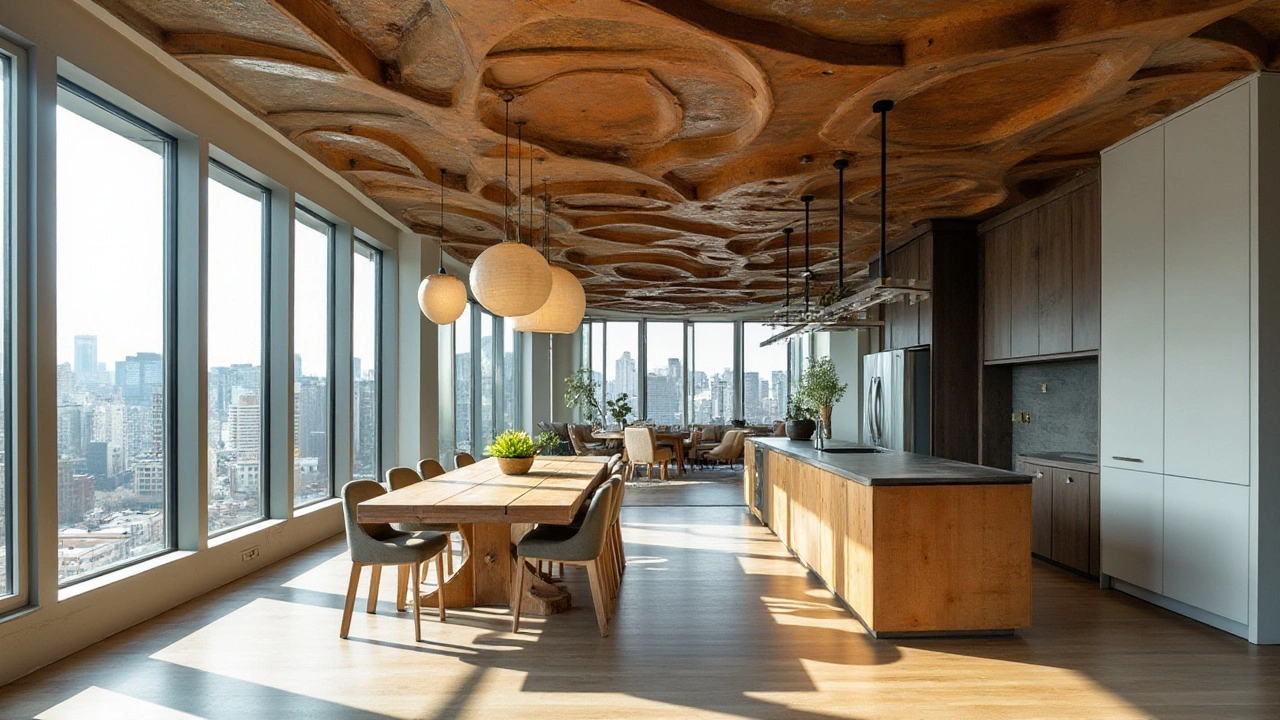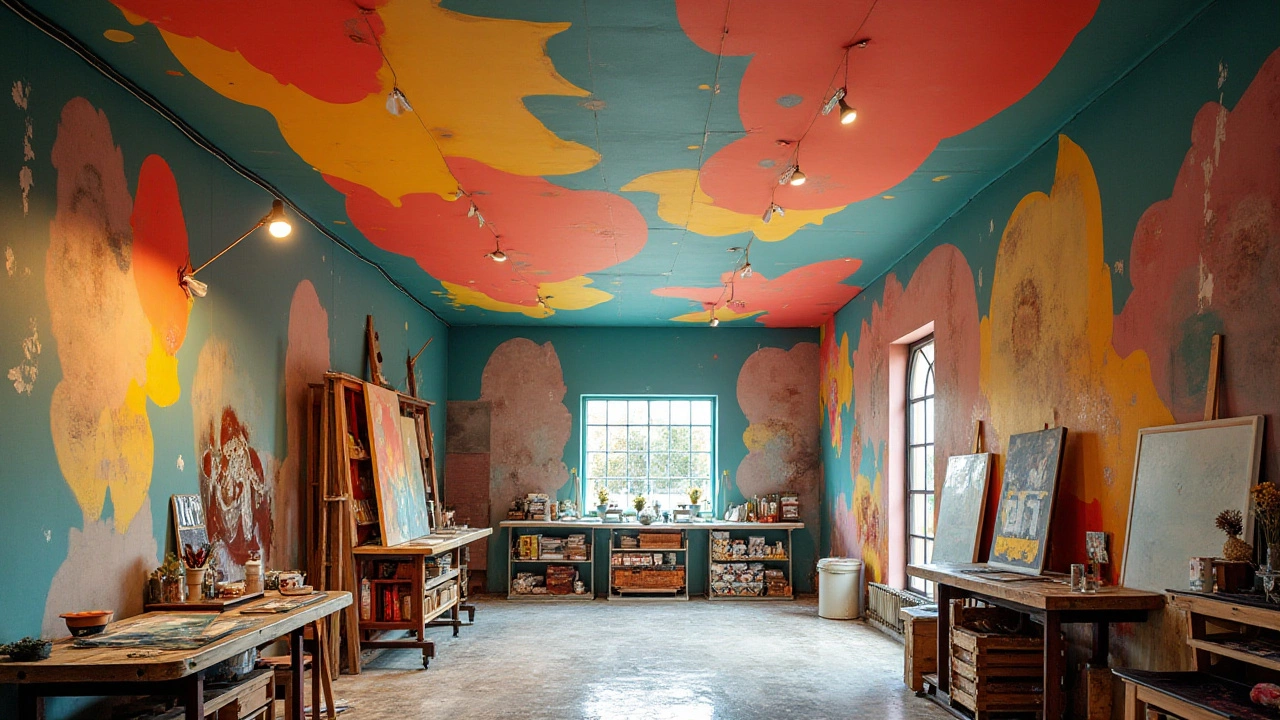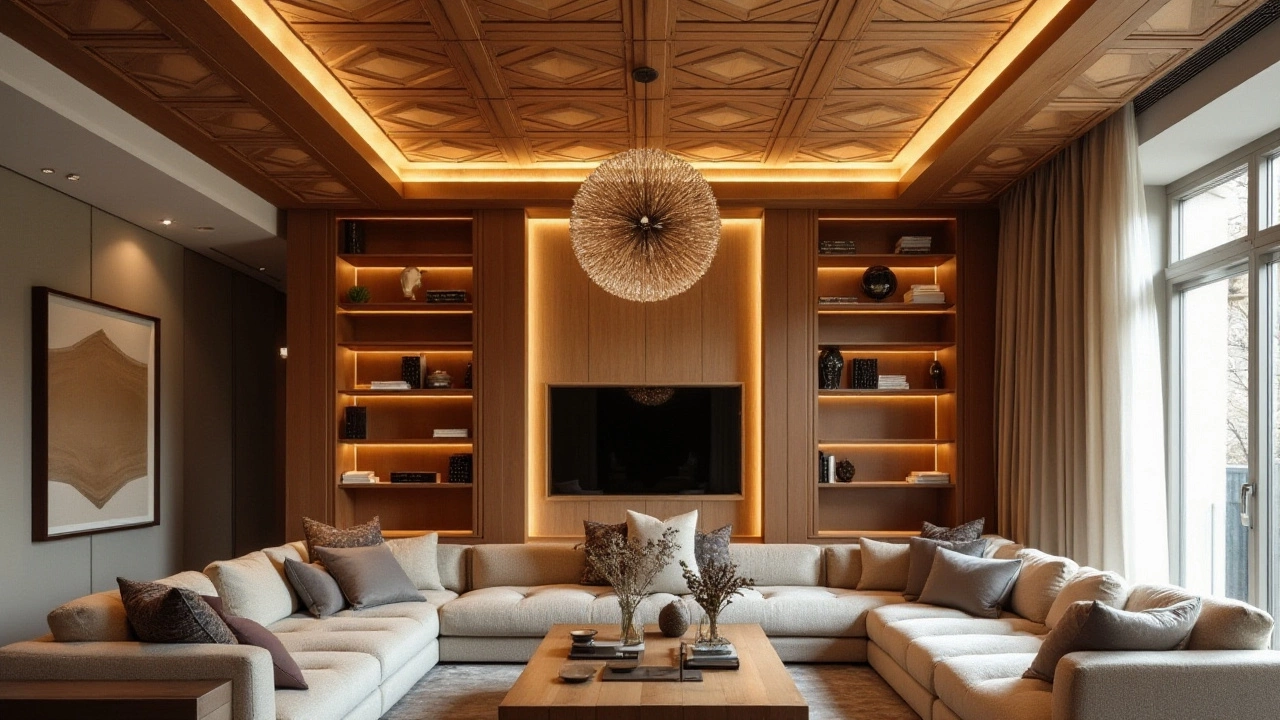In the world of home design, ceilings have emerged as a canvas for creativity and innovation in 2024. Gone are the days of plain white expanses overhead; today, homeowners and designers alike are embracing the potential of ceilings to transform living spaces into works of art. The ceiling is no longer an afterthought—it commands attention with textures, colors, and technologies that bring depth and personality to any room.
This year's trends highlight ceilings that are interactive and expressive, encompassing everything from sustainable materials to smart technology integration. Whether you're revamping a single room or redesigning an entire home, keeping an eye on these trends can elevate your space to new heights. Imagine a ceiling that is both a visual delight and a functional part of your living environment. With these insights, you can create a space that not only reflects personal style but also invites admiration from anyone stepping into your home.
- Texture Galore: Elevating Ceilings with Depth
- Sustainable Materials for Modern Ceilings
- Bold Colors and Patterns Making a Statement
- Innovative Lighting Solutions for Ceilings
- Artistic and Architectural Ceilings
- Smart Technology Integration Features
Texture Galore: Elevating Ceilings with Depth
In 2024, the game of ceiling design has significantly stepped up with an explosion of textures redefining the conventional boundaries of interior decor. From subtle patterns to bold, tactile designs, textures are infusing ceilings with character and warmth, creating inviting atmospheres while adding dimension to spaces. Textured ceilings are gaining ground as a focal point, drawing the eye upward and showcasing the ingenuity that homeowners crave. These innovative designs provide a sensory experience that is as captivating to touch as it is to behold. No longer limited to walls or floors, textures have unapologetically claimed their place above, offering a canvas for creativity that is both functional and aesthetic.
The rise in popularity of textured ceilings can be attributed to the artistry and craftsmanship they represent. One of the resounding favorites is the use of wood panels, which imbue rooms with a natural, organic feel. Whether opting for reclaimed timber or sleek, modern finishes, wooden ceilings are celebrated for their versatility. Beyond wood, metals like tin and copper are being stamped into playful patterns, giving a nod to vintage inspirations while fitting into contemporary settings. An array of materials such as plasters and stuccoes are also making their mark, each leaving distinctive imprints on the ceilingscape.
Adding texture to a ceiling is more than an aesthetic choice—it’s about creating a mood. Certain textures can soften harsh lighting, making spaces feel more serene. Intricate patterns not only add visual interest but can also be customized to fit personal tastes and architectural styles, bridging the gap between modernist homes and rustic retreats. Take the trend of using embossed wallpaper for ceilings, for instance, which offers a quick and cost-effective way to reinvent ceilings without structural changes. The choice and placement of textures can transform a ceiling from a mere overhead cover to a fundamental part of the narrative of the room. One might consider the work of renowned designer Kelly Wearstler, who states:
"A ceiling is a key architectural element; it defines and helps compose the design envelope of a room. The texture is its language."
As you contemplate redesigning your own ceilings, the ceiling trends of 2024 present an opportunity to experiment beyond traditional, flat designs. Think about the interplay of light and shadow, how different times of the day might highlight new facets of the pattern you've chosen. Textured ceilings can conceal imperfections and even absorb sound, making rooms feel both grander and more acoustically pleasant. Whether aiming for a bold statement or a subtle enhancement, the addition of texture can turn the ceiling into a captivating architectural component, dramatically changing the way a space feels.
Sustainable Materials for Modern Ceilings
As environmentally conscious practices continue to shape design choices, incorporating sustainable materials in ceiling designs has become an invigorating trend for 2024. This shift not only reduces environmental impact but also enhances the aesthetic appeal of interior spaces. One popular choice is reclaimed wood, which lends a rustic charm while telling a story of its own. Each plank, suiting both modern and traditional settings, comes with a history that adds character and warmth to your home. By utilizing wood that has served another purpose, we can minimize deforestation and the carbon footprint associated with new material production. Such eco-friendly options are central to ceiling trends 2024.
Natural Fibers and Bio-based Materials
Natural fibers like bamboo and hemp are making waves in the design world, and they are being skillfully adapted for ceiling installations. Bamboo, known for its rapid growth and renewability, offers a lightweight yet durable solution for those looking to embrace green building practices. It's particularly suited for creating grid and panel ceiling designs that exude a simplistic elegance. Meanwhile, hemp's versatility allows it to be woven into acoustic panels and insulation coatings that enhance both the aesthetics and functionality of interior spaces. Such materials not only improve indoor air quality but also provide thermal and acoustic benefits, making them an impeccable choice for eco-conscious homeowners.
"The use of sustainable materials in design drives ecological integrity and fosters a connection between our living spaces and the natural world," declares Michael Rhodes, a pioneer in sustainable architecture and design.
Recycled Metal and Innovative Composites
For those seeking a modern and industrial edge, recycled metal ceilings are an excellent choice. By repurposing metals like aluminum or steel, manufacturers can create sophisticated ceiling panels that are as strong as they are stylish. These materials are not only recyclable but also reflectivity increases lighting efficiency, saving energy in the long run. Additionally, new-age composites made from agricultural by-products are gaining traction. These composites transform waste into chic ceiling panels, reducing landfill contributions while offering unique patterns and textures. Such innovations underscore how home decor ceilings can be both visually captivating and environmentally responsible.
Going Beyond with Eco-Friendly Paints and Finishes
It’s not just about the structural materials themselves — finishes play a crucial role in enhancing the sustainability of ceiling designs. Paints with low or zero volatile organic compounds (VOCs) are increasingly sought after, as they minimize toxic emissions that compromise indoor air quality. Such paints come in a variety of colors and sheens, facilitating creative expressions without sacrificing health. There’s also a growing interest in natural clay or lime plasters that bring not only aesthetic variety but also contribute to regulating a room’s humidity. Adopting these environmentally-friendly coatings not only complements the sustainable materials used but also provides an overall sense of well-being in your living spaces.
Economics of Sustainable Ceiling Choices
Interestingly, while the initial cost of sustainable materials might be perceived as higher, the long-term savings they offer far outweigh the upfront investment. With energy-efficient properties and heightened durability, these materials reduce the need for frequent replacements and energy consumption. Ultimately, the economical benefits of sustainable ceiling options extend beyond mere cost-savings. There is a burgeoning market for eco-friendly homes, often fetching a premium due to their reduced ecological footprint and health advantages. This reflects broader consumer trends towards responsible and thoughtful living. Incorporating these materials not only prepares a space for the future but also makes a significant contribution to global sustainability efforts. Truly, integrating modern ceiling styles with sustainable approaches signifies a commitment to nurturing our planet while redefining home decor paradigms.

Bold Colors and Patterns Making a Statement
In 2024, the trend of bold colors and patterns on ceilings has captured the imagination of designers and homeowners alike, heralding a shift from traditional white and neutral tones. This daring approach to ceiling decor is about expressing individuality and taking risks with design elements that were once considered unconventional. By transforming the ceiling into a focal point, spaces are infused with personality and character.
Homeowners are embracing a rich palette that ranges from deep royal blues and emerald greens to sophisticated charcoal hues and even vibrant shades like mustard yellow and bordeaux. These bold choices create a striking contrast with the walls and flooring, introducing a new dimension to the room. Patterns, particularly geometric designs and abstract motifs, add an artistic flair that elevates the space's aesthetic to a whole new level.
"Ceilings are the new frontier in design. Their potential to impact a room's mood is unparalleled," notes Melissa Warner Rothblum, a renowned interior designer.This trend isn't just about aesthetics—it taps into the emotions that colors evoke. Psychological studies have shown that colors can influence mood, productivity, and even sleep quality. In a living room, a bold-patterned ceiling can energize social gatherings, while in a bedroom, softer yet vibrant tones can create a comforting retreat.
To successfully incorporate this trend, begin by evaluating the existing elements in your room. Consider complementary colors that will enhance the overall design without clashing. When adding patterns, ensure they align with the furniture and accessories, creating a cohesive look. Some people start with a feature area, such as an entryway or a dining room, allowing them to experiment before committing to larger rooms.
For those unsure of where to start, consider consulting with a professional designer. They can provide insight into color theory and pattern selection, ensuring that the finished result is harmonious and aesthetically pleasing. Whether you're redecorating an existing space or designing from scratch, bold colors and patterns can make your ceiling not just another surface, but the standout feature of your home.
Innovative Lighting Solutions for Ceilings
Lighting has always been an integral part of interior design, but recent trends have shifted it to an architectural art form, especially when it comes to modern ceiling styles. By incorporating diverse lighting techniques, designers today are shaping spaces that captivate and inspire like never before. From layered lighting schemes to fixtures that act as focal points, the opportunities are limitless. A particularly popular trend is the use of recessed lighting, which offers a sleek and unobtrusive solution that enhances the contours of a space, making rooms feel larger and more inviting. This style remains favored not only for its minimalism but also for its capability to blend with any décor theme.
Another exciting development in ceiling trends 2024 is the integration of LED light strips, either along architectural lines or hidden within ceiling coves. These strips provide an ambient glow that can be easily adjusted to suit the mood or occasion, with customizable colors and dimming capabilities. They are energy-efficient and have a long lifespan, making them not just a stylish but also a sustainable choice. For those looking to make a bolder statement, pendant lights hung at varying heights add dynamic visual interest and are particularly effective in spaces with high ceilings.
An influential figure in the field of lighting, Jane Felstead of Luminaire Design, emphasizes the transformative power of lighting when she says,
"Lighting is not just about visibility; it's about creating a vibe. The right lighting can change the whole rhythm of a home."By choosing the right fixtures and strategically placing them, homeowners can dramatically affect the tone and functionality of their spaces. Additionally, grid lighting patterns, which use multiple small fixtures in a geometric arrangement, are gaining traction for their modern, organized look.
Of course, with technology's rapid progression, smart lighting systems have become increasingly popular, allowing users to control their ceiling lights via smartphones or voice-activated assistants. This is not just for convenience but also for enhancing energy efficiency. Systems can be programmed to adjust lighting based on the time of day, automatically switching off when rooms are empty, contributing to sustainable living practices. Thus, embracing these technologies not only modernizes a home but also offers a practical approach to reducing energy consumption.
For those interested in a touch of luxury, chandeliers remain timeless, yet with a modern twist. Contemporary designs embrace unconventional materials and shapes, diverging from traditional crystal to incorporate metals, woods, and even glass in striking silhouettes. Ceiling-mounted fiber optic lighting is another cutting-edge option, transforming any ceiling into a starry night or other bespoke designs, ideal for home theatres or relaxing personal spaces. This technology can simulate diverse celestial patterns, providing endless customization possibilities.
Let's not forget the appeal of incorporating interior design ideas that focus specifically on themed lighting. Drawing inspiration from nature, fixtures shaped like leaves, branches, or other organic forms bring an element of the outdoors inside, which can be particularly soothing in urban environments. The emergence of biophilic design seeks to reconnect people with nature through architectural elements and lighting can play a pivotal role in achieving this aesthetic.

Artistic and Architectural Ceilings
Artistic and architectural ceilings have become a pivotal trend in 2024, creating an exquisite synergy of design and structural marvel that captivates the imagination. These ceilings are not merely functional; they have taken on an art form that complements and enhances interior spaces with striking creativity. From intricate moldings and frescoes reminiscent of classic architecture to daring modern installations, artistic ceilings are making bold statements in homes today. One of the most fascinating aspects of these designs is their ability to merge art with architecture seamlessly. By treating the ceiling as an extension of the walls and floors, designers are crafting cohesive spaces that echo a specific aesthetic or theme throughout the house.
Incorporating artistic elements into ceilings can transform ambient atmospheres. For instance, a ceiling adorned with a sprawling fresco might conjure the elegance of Renaissance art in a living room, enveloping it in historical charm. Meanwhile, a modern home might boast geometric patterns or abstract designs that not only please the eye but also engage occupants in a visual dialogue about shape and form. An architectural ceiling can pivot between subtlety and drama, allowing homeowners to tailor their spaces to either seamlessly blend or boldly contrast within the existing decor.
"The ceiling is the forgotten space in home design— yet it holds endless potential for transformation," says interior designer Jonathan Marks.
The rise of architectural ceilings has also been buoyed by technological advances. Modern 3D printing and computer-aided designs allow for precise and intricate details previously deemed difficult to achieve. This technological infusion enables designers to experiment with new textures and structures, resulting in visually captivating ceilings that defy conventional flatness. Moreover, these technologies are being effectively used to replicate classical motifs with a contemporary twist, offering the comfort of tradition with innovative flare.
Architectural ceilings are not solely about aesthetics; they can have practical value too. Improved acoustics, through innovative ceiling geometries, enhance sound quality making entertainment rooms and home theaters sound balanced and vibrant. Meanwhile, strategic use of modern ceiling design can bolster natural lighting, guiding light deeper into buildings' interiors. Such practical applications offer immense value by optimizing both functionality and beauty. With sustainability in mind, many are turning to eco-friendly materials, opting for recycled woods and sustainable fabrics, hence contributing to an environmentally conscious design approach. With architecture and art so intricately weaved into these ceiling designs, the home becomes not just a living space but a living gallery.
Smart Technology Integration Features
In 2024, the integration of smart technology into the design of ceilings is revolutionizing the way we interact with our living spaces. This trend isn't just about incorporating technology for the sake of it; it's about creating environments where technology serves practical purposes while enhancing the aesthetic appeal. Imagine a scenario where your ceiling not only lights up a room but also responds to voice commands, changes color based on the time of day, or even works as part of your home security system.
One of the most popular smart technologies finding its way into ceilings is smart lighting. These systems allow homeowners to control lighting intensity and color through mobile apps or voice assistants like Alexa and Google Home. The transition from warm to cool light can be automated to suit different times of the day, providing not just lighting but also a mood-setting tool that enhances the ambiance of the space. According to a study by the International Journal of Environmental Research and Public Health, lighting can significantly impact mental health and productivity, making this feature far more than just a technological gimmick.
Another exciting development is the integration of automated climate control systems directly into ceiling structures. By embedding sensors and precision air distribution modules into ceilings, homes become more energy-efficient, maintaining the perfect temperature with minimal energy consumption. As cities push towards greener solutions, these innovations not only cut down electricity bills but also reduce carbon footprints. In 2024, around 30% of newly constructed homes in urban areas have adopted some form of smart climate control integration, further showcasing this trend's growing popularity.
"The future of smart home technology lies in seamless integration, and ceilings have become an unexpected frontier for innovation," shares Jessica Langston, a leading voice in interior technology design.
Beyond practical functions, smart ceilings are also playing an integral role in entertainment and home security. Concealed speakers integrated into ceiling tiles can produce high-fidelity sound throughout a room, creating an immersive audio experience without the clutter of visible devices. Security cameras and alarms can be discreetly fitted into these designs, offering peace of mind without disturbing the decor's harmony.
The shift towards integrating smart tech into home design aligns with a broader evolution towards smart living, where homes anticipate and react to residents' needs. While the practical benefits are clear, for many, it's the combination of these functions with the aesthetic enhancements they bring to ceiling designs that make this trend particularly appealing. As these technologies become more accessible and refined, expect to see even more innovation in ceiling designs throughout 2024 and beyond.





